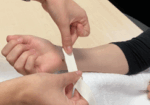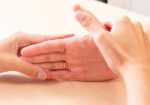Splinting and Stretch Protocol for Pediatric Trigger Thumb
Filed under Treatments
Tan, A. C., Lam, K. S., & Lee, E. H. (2002). The Treatment Outcome of Trigger Thumb in Children. Journal of Pediatric Orthopaedics B, 11(3), 256-259.
The Skinny:
Pediatric trigger thumb is a “relatively uncommon” condition of unknown origins. Studies have indicated that spontaneous recovery of trigger thumb is around 25-40%, and chances increase with age. Meanwhile, implementation of conservative treatment splint therapy, in conjunction with passive stretch programs (pediatric trigger thumb exercises), have shown successful recovery rate as great as 89%.
This review analyzes the success of nighttime/naptime only thumb extension orthotic wear in conjunction with a passive stretch exercises protocol (pediatric trigger finger exercises).

In the Weeds:
115 patients with noted flexion contracture deformity or present triggering/snapping were reviewed. Boys and girls were equally affected, as were left and right thumbs. 23 children had bilateral thumb involvement.
59 children, with an average age of 26.5 months, were treated surgically with A1 pulley release. 56 children, with an average age of 19 months, were treated conservatively with splint therapy.
Splint therapy consisted of nighttime/naptime wear of a thumb extension orthotic (see image) with regular clinic sessions for passive stretch to the thumb, and splint modifications to increase thumb/IP extension (pediatric trigger thumb splint).
Bringing It Home:
Conservative treatment showed an overall success rate of 66%. The success rate decreased with increasing age: from 89% in the under 1 year-old age group to 50% in the over 3 year-old old age group.
Of the 56 patients having conservative treatment, 31 had splint therapy and 25 had passive stretch only. Splint therapy resulted in 77% success rate compared to 52% with the stretch-only group, demonstrating that use of orthotic in conjunction with passive stretch shows the best recovery. Overall, 76% of patients were successfully treated conservatively within 6 months.
For those patients who underwent surgery, either initially or after failed conservative treatment, 1.4% had a recurrence of triggering, and 2.8% had subsequent wound infection requiring treatment with antibiotics.
Limitations: This article asserts that trigger thumb in pediatrics is most likely attributed to acquired injury rather than a congenital anomaly, as none of the participants presented with trigger thumb prior to
six months of age. However, this overlooks the concept that indwelling thumb is developmentally appropriate up through 5 months of age, so observation of thumb IP flexion or thumb flexion prior to
this age would not indicate referral, even if trigger thumb may be co-occurring.
The article does not directly compare the success rates of surgical versus conservative treatment methods. It explains the success rates of conservative treatments while only stating the failure rates of
surgical intervention, which skews the statistics against each other.
More To Read
Place-and-Hold Versus Active Mobilization Therapy After Flexor Tendon Repair
Title: Passive Mobilization With Place-and-Hold Versus Active Mobilization Therapy After Flexor Tendon Repair: 5-Year Minimum Follow-Up of a Randomized Controlled Trial Article Review By: Tommi Hintnaus Reference: Chevalley, S., Wangberg, V., Ahlen, M., Stromberg, J., & Bjorkman, A. (2024, October 4). Passive Mobilization With Place-and-Hold Versus Active Mobilization Therapy After Flexor Tendon Repair: 5-Year Minimum…
Read MoreDorsal Wrist Pain?
Incorporating Emerging Evidence into Clinical Practice for Patients Experiencing Dorsal Wrist Pain During Weight-Bearing Activities By: Brittany Day Supporting Evidence A randomized control study recently published in the Journal of Hand Therapy found rigid carpal stabilizing taping (CST) to significantly increase passive range of motion, active range of motion, and decrease pain in patients experiencing…
Read MoreWhy Burnout Happens in Hand Therapy and What We Can Do About It.
Why Burnout Happens in Hand Therapy There are several reasons why burnout can occur, this is especially true for healthcare workers. What We Can Do About It Final Thought:Burnout isn’t a personal failure, it is often a systemic issue. But we do have power over how we respond. As hand therapists, we are experts at…
Read MorePain management techniques for Wrist Fractures
Pain management techniques for wrist fractures Distal radius fractures account for 17.5% of all fractures with a median age of 60.23(Candela et.al, 2022). Pain management is a significant part of post wrist fracturetreatment due to limitations that pain incurs. Chronic Regional Pain Syndrome (CRPS) canoccur along with a distal radius fracture but will not be…
Read MoreSign-up to Get Updates Straight to Your Inbox!
Sign up with us and we will send you regular blog posts on everything hand therapy, notices every time we upload new videos and tutorials, along with handout, protocols, and other useful information.






